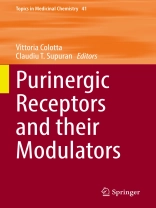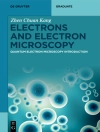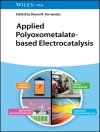This book overviews purinergic receptors that are playing key roles in human and pathophysiological processes. The book elaborates on how selective P1 and P2 modulators have been developed as therapeutics for a variety of diseases. It also provides an overview of current perspectives in the design of purinergic receptor modulators and future challenges such as the availability of selective ligands for all receptor subtypes.
Divided into 12 chapters, this comprehensive volume also offers a multidisciplinary perspective on the historical evolution, starting with a chapter devoted to the roots and early discoveries of adenosine and its receptors, followed by a twenty-year retrospective on the synthesis, properties, and functional potential of adenosine receptor ligands, probes, and functional conjugates. In the next chapters, experts in the field delve into topics such as the therapeutic potential of adenosine receptor ligands in wound healing and fibrosis, the therapeutic benefits of A2A receptor antagonists, the A2B adenosine receptor as a target for brain ischemia or demyelination, the development and latest advancements in clinical trials of A3 adenosine receptor ligands. Other chapters describe bifunctional tools to study adenosine receptors, allosteric modulators of adenosine receptors, and new computational approaches to inspect adenosine receptor-ligand recognition processes. Furthermore, the book discusses the role of P2X4 receptors in immunity and inflammation. The final chapters illustrate CD73 inhibitors as antitumor agents, and bacterial ectonucleotidases as underexplored antibacterial drug targets.
This book is a valuable resource for scholars working in the field of medicinal chemistry, as well as researchers in the industry, providing readers with a comprehensive understanding of adenosine receptor biology and its therapeutic potential.
Зміст
Once upon a time adenosine and its receptors. Historical survey and perspectives as potential targets for therapy in human diseases.- Adenosine receptor ligands, probes and functional conjugates: A twenty-year history of pyrazolo[4, 3-e][1, 2, 4]triazolo[1, 5-c]pyrimidines (PTP).- Adenosine receptor ligands as potential therapeutic agents for impaired wound healing and fibrosis.- Adenosine A2A receptor antagonists: chemistry, SARs, modeling studies and therapeutic potential.- A2B Adenosine Receptor as a new and attractive target to treat brain ischemia or demyelination.- A3 adenosine receptor ligands: from discovery to clinical trials.- Bifunctional tools to study adenosine receptors.- Allosteric modulators of adenosine receptors.- New computational approaches in inspecting adenosine receptor-ligand recognition process.- P2X4 receptors in immunity and inflammation.- CD73 inhibitors as antitumor agents.- Bacterial ectonucleotidases- underexplored antibacterial targets.
Про автора
Vittoria Colotta is an Associate Professor of Medicinal Chemistry at Dipartimento Neurofarba, Universita` degli Studi di Firenze, Sezione di Scienze Farmaceutiche e Nutraceutiche, Italy. She completed her degree in Pharmaceutical Chemistry and Technology in 1985 and her Ph D in Medicinal Chemistry in 1988, both at University of Florence. Her past research interest was the synthesis of new biologically active compounds designed as ligands of benzodiazepine and glutamate receptors. Current research is mainly focused on the development of adenosine receptors’ ligands and inhibitors of the enzymes 5′-ectonucleotidase (CD73), carbonic anhydrases and casein kinases 1 and 2. The aim of the work is the identification of selective or multitarget-directed ligands as potential therapeutic agents for cancer and neurodegenerative diseases. She is co-author of more than 110 peer-reviewed articles and co-inventor of 2 Patents. She is an Editor of the journal Pharmaceuticals and a Review Editorof Frontiers in Pharmacology (Experimental Pharmacology and Drug Discovery section). She is an active reviewer for high-impact medicinal chemistry journals.
Claudiu T. Supuran is a Full Professor of Medicinal Chemistry at Dipartimento Neurofarba, Universita` degli Studi di Firenze, Sezione di Scienze Farmaceutiche e Nutraceutiche, Florence, Italy. He received his BSc in Chemistry from the Polytechnic University of Bucharest, Romania (1987), and Ph. D. in Chemistry at the same university in 1991. His research interests focus on drug development against Carbonic anhydrases and other enzymes. He has published 2000+ research articles on enzyme inhibitors/activators, being one of the most cited medicinal chemists worldwide. His research is also focused on metalloenzymes cloning, characterization and inhiibtion studies, carbonic anhydrases, proteases, heterocyclic chemistry, chemistry of sulfonamides, sulfamates and sulfamides, X-ray crystallography ofmetallo-enzymes, biologically active organo-element derivatives, quantitative structure-activity relationship (QSAR) studies, metal-based drugs, cyclooxygenases inhibitors, serine proteases, matrix metalloproteinases, bacterial proteases, antivirals, antitumor drugs, ophthalmologic drugs and amino acid derivatives. One sulfonamide carbonic anhydrase inhibitor discovered in his laboratory, SLC-0111, completed Phase I clinical trials as antitumor/antimetastatic agent in 2014 and is presently in Phase Ib/II clinical trials in North America, being developed for the treatment of advanced, metastatic solid tumors.












